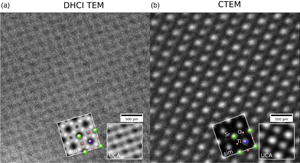Published online by Cambridge University Press: 10 June 2020

Multiple electron scattering and the nonintuitive nature of image formation with coherent radiation complicate the interpretation of conventional transmission electron microscopy images. Precession of the illuminating beam in transmission electron microscopy (TEM) can lead to more robust and interpretable images with some penalty to image contrast, a technique known as dynamic hollow-cone illumination TEM. We demonstrate direct and robust imaging of light and heavy atoms in a crystalline environment with this technique. This method is similar to the annular bright-field technique in scanning transmission electron microscopy, via the principle of reciprocity. Dynamic hollow-cone illumination TEM is challenging in practice due to sensitivity to the misalignment of the precession axis, microscope objective aperture, and crystal zone axis.